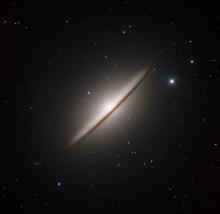Listen to today's episode of StarDate on the web the same day it airs in high-quality streaming audio without any extra ads or announcements. Choose a $8 one-month pass, or listen every day for a year for just $30.
You are here
Monster Black Hole
The black holes at the hearts of galaxies are described as “supermassive.” The one in the middle of the Milky Way, for example, is about four million times the mass of the Sun.
Yet “supermassive” doesn’t feel even close to adequate for describing one of the biggest black holes yet discovered. It’s roughly 34 billion times the mass of the Sun — heavier than many entire galaxies. At that mass, it would be about 20 times wider than the orbit of Neptune, the most remote major planet in the solar system.
The black hole sits at the center of a galaxy called SMSS J2157. It’s along the border between the constellations Grus and Piscis Austrinus — a point that scoots low across the south on October evenings.
The black hole is “eating” the equivalent of one Sun every day — more than any other black hole yet discovered. That surrounds the black hole with a disk of hot gas. The disk glows thousands of times brighter than the entire Milky Way Galaxy. Such bright, compact objects are known as quasars.
J2157 is so far away that we see it as it looked when the universe was less than one-tenth its current age. And that’s a problem. Current models can’t really explain how a black hole could get that big in that short a time.
So J2157 is an unexplained super-bright quasar powered by a super-supermassive black hole — a super-interesting monster near the edge of the observable universe.
Script by Damond Benningfield






